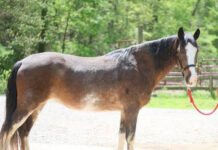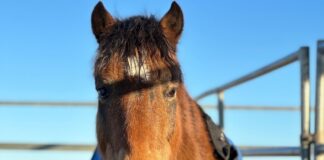If you’re a people person with a passion for horses in need, running an equine adoption facility may be the perfect fit for your skill set. Karen Gustin, Executive Director for the Kentucky Equine Humane Center (KyEHC) in Nicholasville, Ky., explains why she loves her job.
Horse Illustrated: How long have you been in the executive director role at KyEHC?
Karen Gustin: 4+ years
KG: [The KyEHC has] been in existence since 2005. Our mission is to “provide humane treatment and shelter while working to seek adoptive homes and provide second chances for Kentucky’s equines; to educate the public and raise awareness for responsible equine ownership so that fewer horses end up in crisis; to work with and serve as a model for organizations with the same mission in other states; to save America’s equines from inhumane treatment.”
HI: What is your background with horses? Do you still own horse? If so, what do you do with them?
KG: I was a horse nut as a kid, but in my day, you either owned a horse or took lessons–there was no leasing. I got back into horses by leasing my first two and then took the plunge into equine ownership. Currently, we have three horses: an unregistered Thoroughbred, a registered Swedish Warmblood, and a registered Thoroughbred/Warmblood cross.
HI: What did you anticipate doing when you were younger?
KG: Girl Scouts was a big influence on me and gave me my love of everything outdoors. In high school, I knew I wanted to be a Park Ranger.
HI: What is your educational background?
KG: I have a B.S. in Outdoor Recreation from Colorado State University. I also have my private pilot’s license (though it is not current).
HI: What did you before you came to KyEHC?
KG: I worked for the National Park Service for 31 years in 13 different National Park Service sites; some of the more notable included the Grand Canyon and Olympic National Park. I also worked in Guam for 3 years.
HI: How did you decide to enter the nonprofit field?
KG: I started riding again about 15 or 16 years ago, after a long hiatus. About a year and a half before I left the National Park Service (where I did a lot of work with native wildlife), I started thinking about getting into rehabilitating horses. I eventually reached out to some nonprofits in Kentucky to learn more about the process, and ended up at KyEHC.

HI: Having worked in both the for-profit and nonprofit worlds, what is the difference between the two?
KG: My previous career was in government, which is also not-for-profit, but is different than a private nonprofit, which is what KyEHC is. In the government, everything is run by process and usually that process is long and drawn out. The advantage [to this] is that things are done in an organized and regulated way; the disadvantage is that sometimes it takes a long time, and in some cases, too long. I will say one advantage of the government is that there is some assurance of a certain level of funding from year to year.
One advantage of working for a nonprofit is that the work is much more flexible, fast, and in this world, I can legally ask for money. As a federal employee, I was prohibited from doing that. The disadvantage is that there is always the eternal quest for building and maintaining programmatic funding.
HI: Briefly describe what you do on a day-to-day basis.
KG: The first thing I do every day is to check for the blinking red light…. on the phone, which means there are messages waiting. I spend about 50 percent of my time talking to people who need or want to surrender horses. I meet with donors, organize fundraisers, do payroll, email, Facebook, purchase supplies, keep our Board of Directors in the loop, supervise a small staff (who really doesn’t need supervision because they are great at what they do!), talk to vets, help with horses if needed—on and on. In any nonprofit, especially small ones, you learn to wear many hats.
HI: Do you travel for your job at all? If so, about what percentage of your job includes travel?
KG: I travel within the state of Kentucky and very occasionally outside the state. I would estimate 10 to 15 percent of my time is traveling.
HI: Are there many other places other than Lexington where you could do this job or is it very region specific?
KG: There are horse rescues all over the country and there is a huge need for them. BUT, Lexington is the bee’s knees for all things equestrian!
HI: What is your favorite part of your job?
KG: I love the horses! And, I love watching a decrepit, depressed horse come back to life and flourish. Sometimes it is pretty miraculous. We really do give horses a second chance when often no one else would. We see magic happen at this place and I feel humbled to be a part of it.
HI: Did you have any experiences that really stuck with you that made you want to do this job?
KG: I love horses and I love the outdoors. After my career with the NPS, I feel very lucky to have a second career that I am just as passionate about. Horses are beautiful, big and bold animals and they have a tremendous amount to teach us.
HI: What do you think are key qualities for people who might want to go into your field?
KG: You have to have persistent drive, enjoy working with people, have flexibility and possess attention to detail. You also cannot get discouraged or give up when things don’t go as planned. A positive attitude is imperative.
HI: What is a difficult part of your job?
KG: I think about money every day—it’s called financial fatigue!
HI: How do you not get burned out? How do you retain your passion for what you do and not get angry with people?
KG: I am not burned out at all because I love what I do. A lot of people who surrender their horses do so because they are having financial or physical problems. Any one of us could find ourselves in that situation, so I cannot get angry at those people. The other people who are just downright mean or negligent … you would make yourself crazy being angry, so I just don’t go there.
HI: What is one thing you learned or know now you never would have expected from this job?
KG: When I first started here, I thought it was all about saving skinny horses–which it often is–but often we are also helping people through difficult transitions in their lives.
Also, I am amazed at how supportive people can be when you ask. Maxie’s story is a good example of that.
HI: What advice would you give people who are interested in pursuing a career in a nonprofit organization?
KG: As a small nonprofit, you must be willing to be available at all times. You must realize that the responsibility for getting things done rests with you, not some larger entity. You have to be comfortable handling things on your own, with little supervision.
Find out more about the KyEHC on their website and Facebook page.
Running a nonprofit isn’t for you? Maybe
being a horse show judge, saddle fitter, or something else
will capture your interest. Find out! See more Careers in the Horse Industry interviews >>






